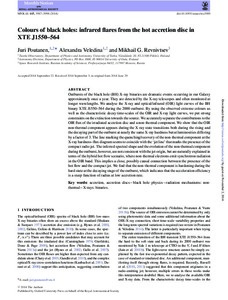Colours of black holes: infrared flares from the hot accretion disc in XTE J1550-564
Veledina A.; Poutanen J.; Revnivtsev M.G.
https://urn.fi/URN:NBN:fi-fe2021042715419
Tiivistelmä
Outbursts of the black hole (BH) X-ray binaries are dramatic events occurring in our Galaxy approximately once a year. They are detected by the X-ray telescopes and often monitored at longer wavelengths. We analyse the X-ray and optical/infrared (OIR) light curves of the BH binary XTE J1550–564 during the 2000 outburst. By using the observed extreme colours as well as the characteristic decay time-scales of the OIR and X-ray light curves, we put strong constraints on the extinction towards the source. We accurately separate the contributions to the OIR flux of the irradiated accretion disc and a non-thermal component. We show that the OIR non-thermal component appears during the X-ray state transitions both during the rising and the decaying part of the outburst at nearly the same X-ray hardness but at luminosities differing by a factor of 3. The line marking the quenching/recovery of the non-thermal component at the X-ray hardness–flux diagram seems to coincide with the ‘jet line’ that marks the presence of the compact radio jet. The inferred spectral shape and the evolution of the non-thermal component during the outburst, however, are not consistent with the jet origin, but are naturally explained in terms of the hybrid hot flow scenario, where non-thermal electrons emit synchrotron radiation in the OIR band. This implies a close, possibly causal connection between the presence of the hot flow and the compact jet. We find that the non-thermal component is hardening during the hard state at the decaying stage of the outburst, which indicates that the acceleration efficiency is a steep function of radius at low accretion rate.
Kokoelmat
- Rinnakkaistallenteet [19207]
